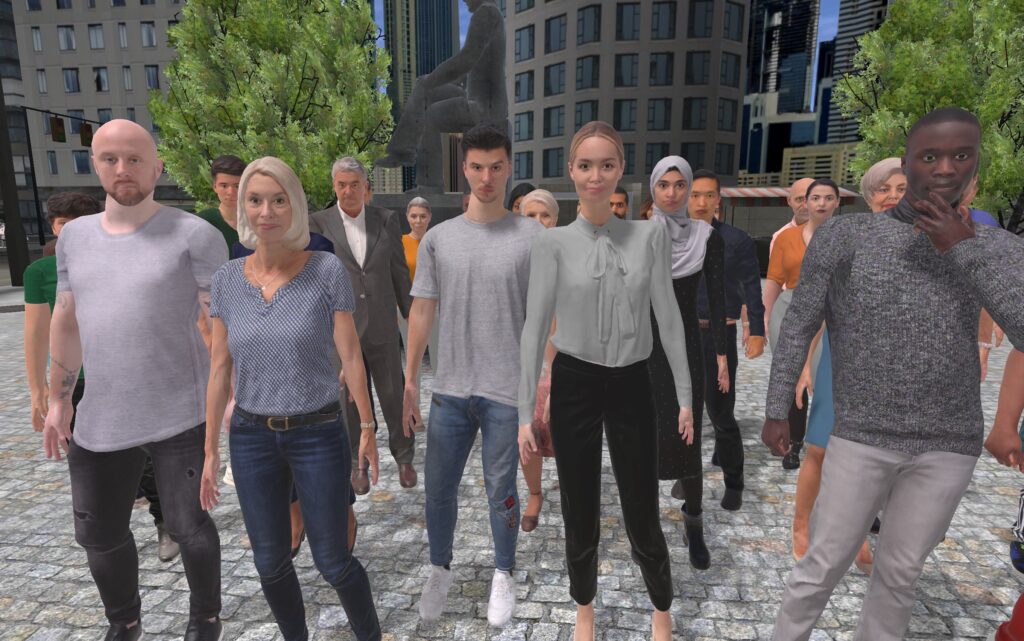Artificial Intelligence
at C2Care !
We combine VR and AI for an immersive, personalized experience.

Why Use AI ?
Although virtual reality is a powerful tool, it alone is not enough to deeply address the social dimension of anxiety, which is central to many issues. To be truly effective, this method must allow users to practice interacting with others. This is where artificial intelligence plays a key role.
Thanks to an artificial intelligence specifically trained to support individuals facing emotional difficulties, and the integration of an intelligent chatbot based on the latest generation language models (LLM), our solution enables users to practice key social situations of daily life: simulating a romantic date, preparing for a job interview, or starting a conversation with a stranger in the street.
Each exposure thus becomes interactive and the immersion, complete !
Receive the C2Care method for free, combining Artificial Intelligence and Virtual Reality !
Our AI solutions
Our AI solutions
Camille, your well-being ally
Camille, your well-being ally
More than just a virtual assistant, Camille is your new well-being ally!
In every environment, she will stay by the user’s side to answer questions, provide reassurance, and offer encouragement throughout the exposure.Designed to provide a caring and supportive space, she will act as a trustworthy conversational partner, someone you can confide in without fear of judgment.
Camille is accessible 24/7, providing continuous support regardless of time constraints or location. This availability is especially valuable for individuals who struggle to access services due to their schedules or geographic location.
3D avatars

3D avatars
Thanks to artificial intelligence, it is now possible to interact with every virtual character as if they were real people. Whether it’s a neighbor on the subway, a passerby on the street, or a colleague in an elevator, you will encounter familiar figures in your exposure sessions. These NPCs (Non-Player Characters) create a more immersive experience in virtual environments, making anxiety management training more effective.
This tool is particularly beneficial for individuals practicing situations such as romantic dates, job interviews, or social gatherings with friends. It helps develop strategies to better manage emotional and behavioral responses in these specific contexts.
Guided meditation

Guided meditation
Unwind after a long day, refocus on your emotions, or ease into sleep smoothly: our meditation sessions cater to every need with customized and diverse scenarios.
Natural landscapes like a sunny beach, a peaceful forest, or a cozy fireplace create a multisensory escape, perfect for relaxation.
With AI-generated dynamic hypnosis scripts, each session becomes a unique relaxation experience. This innovative approach allows for deep relaxation moments, accessible to everyone, anytime.
Lives changed thanks to our method.
Our commitment to your personal data
C2Care’s AI solutions are powered by OpenAI’s engine, designed to offer seamless and tailored interactions while adhering to the highest security and privacy standards.
OpenAI implements several measures to protect its users :
Data privacy
OpenAI complies with international data protection regulations, such as GDPR, ensuring the security and confidentiality of users’ personal information.
Transparency
OpenAI is committed to making its algorithms and operational processes as transparent as possible. This allows users to understand how their data is processed and how AI interacts with them.
Enhanced security
OpenAI continuously invests in improving system security to prevent unauthorized or malicious use of AI.
Ongoing monitoring
OpenAI conducts regular audits and implements monitoring mechanisms to detect and correct any potential issues, ensuring a reliable and secure experience.
Our Artificial Intelligence Charter
FAQ
Why use virtual reality in the field of mental health?
- Gradual and Controlled Exposure: VR allows patients to confront anxiety-inducing situations in a secure environment, gradually adjusting the intensity of stimuli to promote habituation and emotional regulation.
- Realistic and Reproducible Environments: Unlike traditional techniques, VR provides immersive scenarios that can be consistently reproduced, ensuring a coherent and effective approach.
- Increased Patient Engagement: The interactive and immersive nature of VR enhances treatment adherence and motivates patients to continue their therapy.
- Personalized Treatment: Virtual environments can be adapted to meet the specific needs of each patient.
- Versatile Applications: VR is used to treat anxiety disorders (phobias, post-traumatic stress disorder, obsessive-compulsive disorders), addictions, mood disorders, and even cognitive remediation.
How long has this existed?
How does virtual reality work?
What is a virtual environment?
What Equipment Is Needed to Use a Virtual Reality Headset?
Can virtual reality be dangerous?
What pathologies can be treated in virtual reality?
Who can use virtual reality for treatment?
What Are the Benefits for Therapists Using VR ?
- Professional Differentiation: Integrating VR into practice allows therapists to stand out from traditional treatment options.
- Scientific Validation: VRET is backed by extensive research, reinforcing its credibility as an effective treatment method.
- Improved Patient Engagement: The interactive nature of VR fosters greater patient involvement in therapy.
- Time-Saving: VR provides direct access to various exposure environments without needing external logistics.
Which patients can benefit from TERV?
One of the considerable advantages of virtual reality is that it is effective on a wide spectrum of populations. Existing data from the literature on the subject shows us that it is entirely possible to expose a wide age group to virtual reality, with real therapeutic benefits.
The studies attest, in fact, to excellent feasibility and significant results; particularly in adults, in the treatment of anxiety disorders (including school phobia), autism, addictions, eating disorders, neuropsychological disorders, psychotic disorders and mood disorders.
The results are identical for adolescents with a significant added value concerning therapeutic engagement where virtual reality promotes adolescents' interest in their therapy.
Among elderly subjects, study results encourage the use of virtual reality with the aim of working on cognitive stimulation, on behavioral disorders but also on anxiety.
